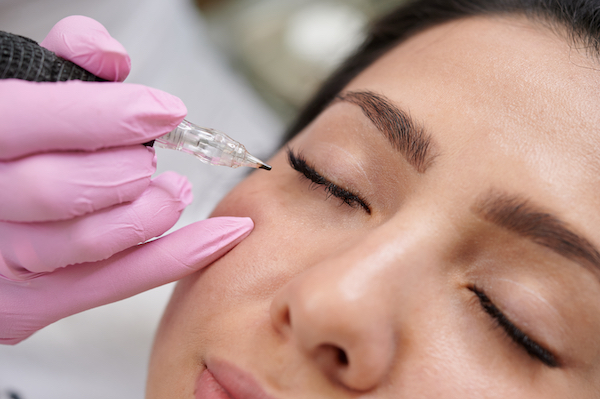
Permanent makeup, also known as micropigmentation or cosmetic tattooing, is a procedure that involves the application of pigments to enhance certain features of the face. It is commonly used to create permanent eyebrows and eyeliner using a tattoo machine. Here is a description of the procedure:
1. Consultation: The process begins with a consultation session with a trained and experienced permanent makeup artist. During this session, the artist will discuss your desired outcome, assess your facial features, and advise you on the most suitable shape, color, and style for your permanent eyebrows and eyeliner.
2. Numbing: Before the procedure, a topical anesthetic is applied to the treatment area to minimize any discomfort or pain during the process. The anesthetic may be in the form of a cream or gel and is left on for a short period to allow it to take effect.
3. Designing: Once the numbing agent has taken effect, the artist will carefully measure and draw the desired shape of your permanent eyebrows or eyeliner using a cosmetic pencil. This step ensures that the final result is symmetrical and suits your facial features.
4. Pigment selection: The artist will help you select the appropriate pigment colors that best match your natural hair color or desired look. They will take into consideration factors such as your natural hair color, skin tone, and personal preferences.
5. Tattooing: Using a specialized tattoo machine, the artist will begin the process of depositing the pigments into the skin. The machine consists of a small, handheld device with a disposable needle or cartridge attached to it. The needle rapidly moves up and down, delivering the pigments into the delicate upper layers of the skin.
For permanent eyebrows, the artist will carefully follow the drawn outline, creating hair-like strokes or shading techniques to mimic the appearance of natural eyebrows. The strokes or shading are built up gradually to achieve the desired fullness and shape.
For permanent eyeliner, the artist will delicately apply the pigments along the lash line, creating a defined line or a more subtle enhancement, depending on your preference and chosen design. They will ensure the pigment is applied evenly and symmetrically on both eyes.
6. Aftercare: Once the procedure is complete, the artist will provide you with detailed aftercare instructions. This typically involves avoiding excessive moisture, exposure to sunlight, and certain activities such as swimming or sauna visits for a few days. Applying a recommended ointment or cream may be necessary to aid in the healing process.
7. Touch-up session: Permanent makeup requires a touch-up session after a minimum of 5 weeks to refine and perfect the results. This allows the artist to address any fading or areas that may need additional pigment. The touch-up session ensures the longevity and desired outcome of the permanent makeup.
It’s important to note that the healing process varies from person to person, and the final results may not be fully visible until the skin has completely healed. Permanent makeup is a long-term solution, but the pigments may fade over time due to factors such as sun exposure, skin type, and individual metabolism.
To ensure a safe and successful procedure, it is crucial to choose a trained and reputable permanent makeup artist who follows strict hygiene practices and uses high-quality pigments and equipment.